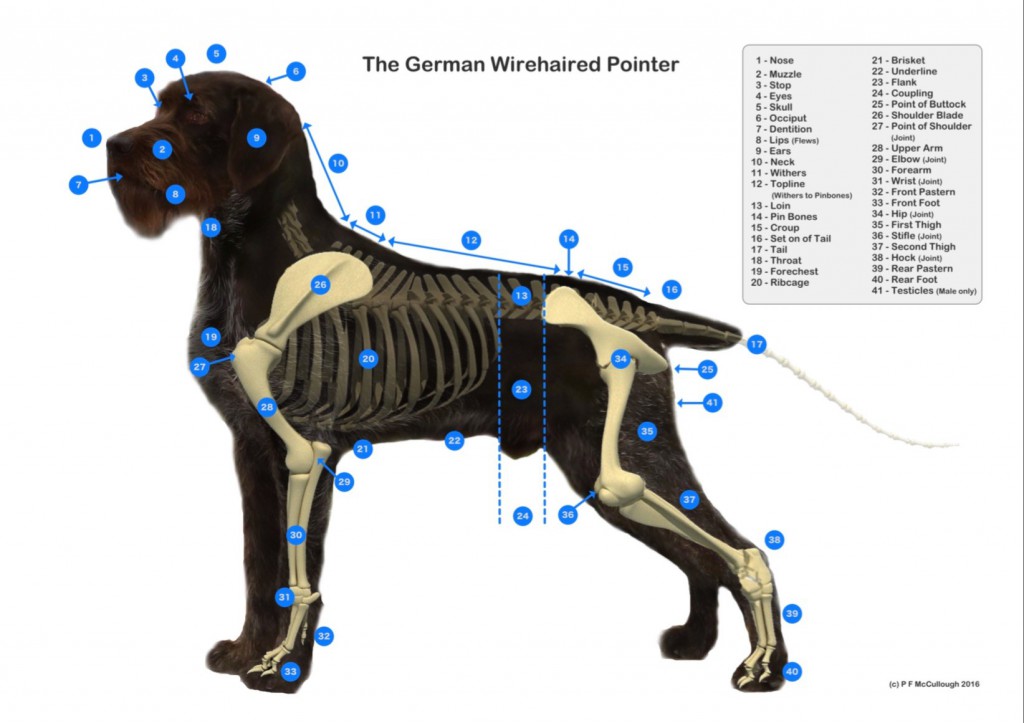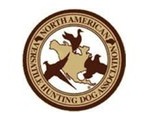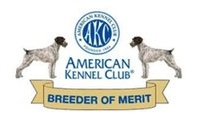German Wirehaired Pointer Standard
Introducing the German Wirehaired Pointer – Photo Standard #1
We put this together as an easier way to explain and exhibit the GWP standard. Bear with us, while we work to complete this into the final stages. A lot of time and detail has been dedicated to this project, and with pups and a 2 year old, there isn’t much extra time!
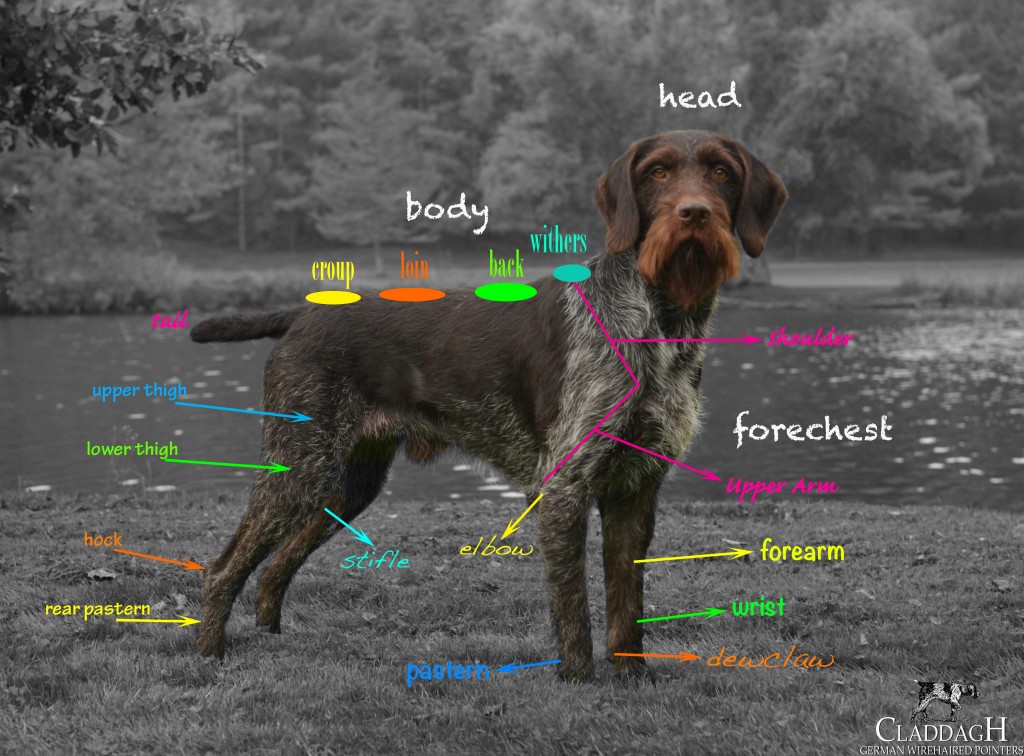
Brief Breed History
The German Wirehaired Pointer (Deutsch-Drahthaar) was created in Germany in the late 19th century by a small group of dedicated sportsman, who set out to develop a versatile hunting dog that would satisfy all aspects of German hunting in field, forest, and water. Their goal was to produce a dog that could find and point game, as well as retrieve on land or in water. The dog should be able to equally work upland birds and waterfowl, as well as fox, rabbits, deer and boar. The dog was to be a calm, family companion, yet brave and able to guard the home and family. They were to have necessary drive and desire to independently search marshes for wounded waterfowl, yet work closely to the gun in thick forests. This group of breeders succeeded in creating a versatile hunting dog that took its traits from the best dogs of the existing coarse hair breeds, cross bred with the shorthair blood. These ancestors included the Stichelhaar, Pudelpointer, Griffon, and the Deutsch-Kurzhaar.
Temperament
“Of sound, reliable temperament, the German Wirehaired Pointer is at times aloof but not unfriendly toward strangers; a loyal and affectionate companion who is eager to please and enthusiastic to learn.” -AKC Standard
Aloof… what does that mean?! By definition: 1. Emotionally reserved or indifferent, 2. Distant or uninvolved
Don’t be fooled, a friendly gwp, with a good temperament will never display shyness or be reserved. You should always expect to be greeted by a dog that’s anxious to lick your face, and with a nonstop wagging tail!
There is no room in society for a gwp with questionable temperament. Most gwp’s will be exposed to children and other dogs, so it’s important to have a stable temperament. A gwp that shy’s away from a judge in a show ring, shall never be allowed the excuse of being ‘aloof’, should not be rewarded, and certainly not continued on in a breeding program.
General Appearance
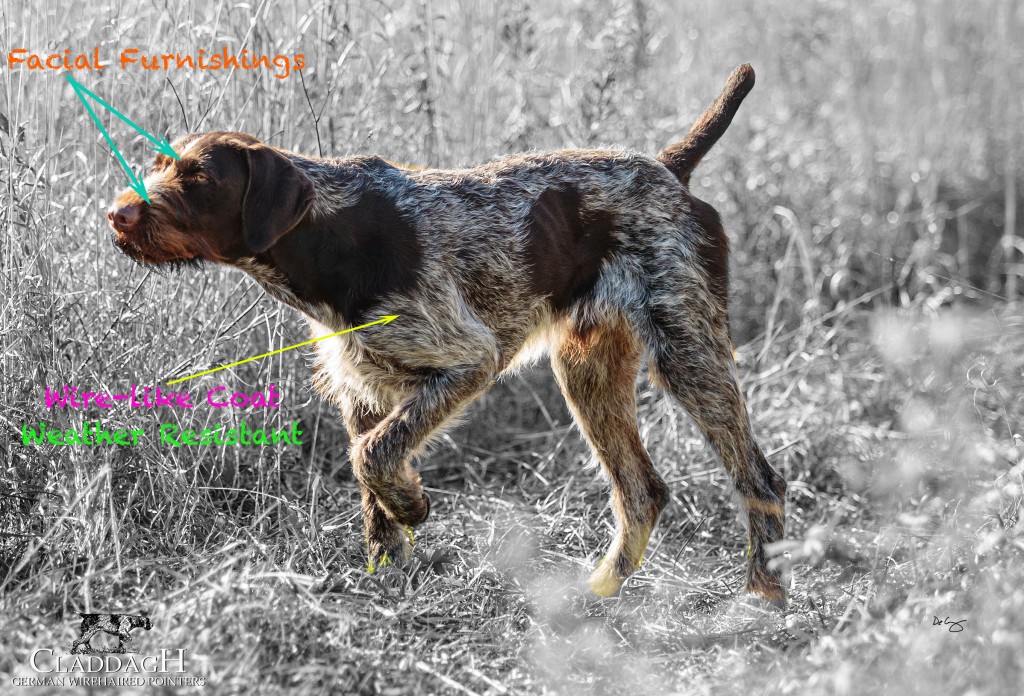
Important Proportions
The height of males should be from 24 to 26 inches at the withers. Bitches are smaller but not under 22 inches. To insure the working quality of the breed is maintained, dogs that are either over or under the specified height must be severely penalized.
The body is a little longer than it is high, as ten is to nine.
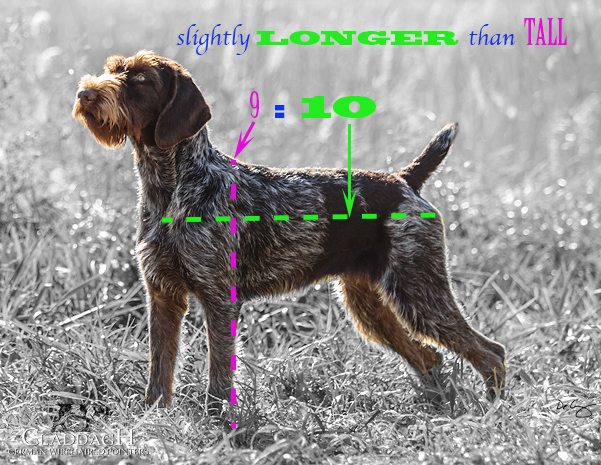
The German Wirehaired Pointer is a versatile hunter built for agility and endurance in the field. Correct size and balance are essential to high performance.
Head:
The head is moderately long. Eyes are brown, medium in size, oval in contour, bright and clear and overhung with medium length eyebrows. Yellow eyes are not desirable. The ears are rounded but not too broad and hang close to the head.
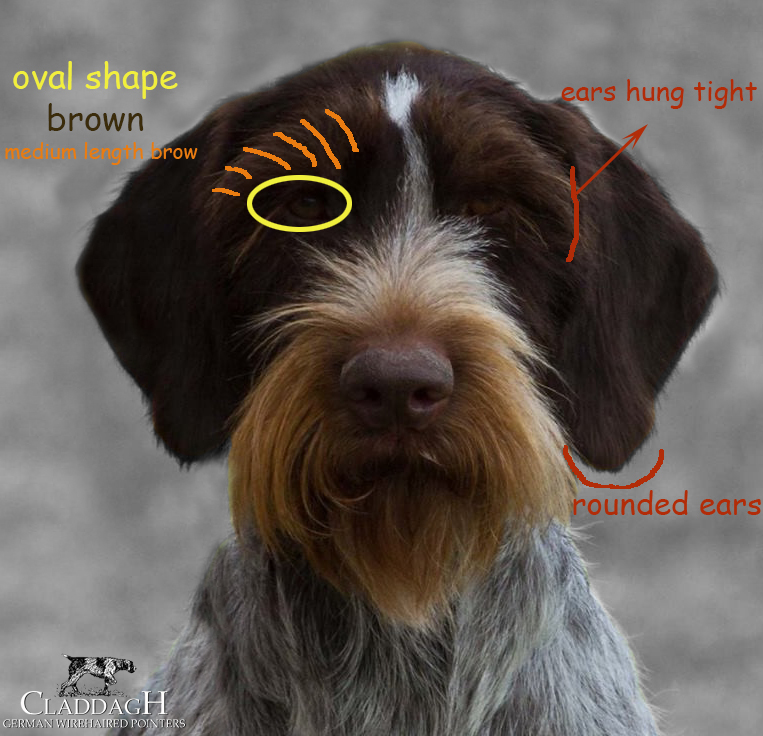
The oval, or almond-shaped eye is less prone to injury, easier to blink, and easier to keep warm. The brow provides protection to the eye in the various cover a gwp hunts in. A tight fitting eyelid is important, as a loose eye is prone to gathering debris such as seeds and weeds.
The color of the eye serves no purpose to the functionality of the breed. A puppy will not have dark eyes, but as long as there is a dark ring around the eye, it will continue to darken with age. A dark eye is preferred, it gives the gwp a nice expression, and blends well with the dark liver pigment of the head.
Ears are medium sized in relation to head, set high, when brought forward should reach the corner of lips.
*Remaining portion of the standard below is still under works for proper illustrations.. stay tuned!*
The skull broad and the occipital bone not too prominent. The stop is medium. The muzzle is fairly long with nasal bone straight, broad and parallel to the top of the skull. The nose is dark brown with nostrils wide open. A spotted or flesh colored nose is to be penalized. The lips are a trifle pendulous but close to the jaw and bearded. The jaws are strong with a full complement of evenly set and properly intermeshing teeth. The incisors meet in a true scissors bite.
Neck, Topline, Body: The neck is of medium length, slightly arched and devoid of dewlap. The entire back line showing a perceptible slope down from withers to croup. The skin throughout is notably tight to the body. The chest is deep and capacious with ribs well sprung. The tuck-up apparent. The back is short, straight and strong. Loins are taut and slender. Hips are broad with the croup nicely rounded. The tail is set high, carried at or above the horizontal when the dog is alert. The tail is docked to approximately two-fifths of its original length.
Forequarters: The shoulders are well laid back. The forelegs are straight with elbows close. Leg bones are flat rather than round, and strong, but not so heavy or coarse as to militate against the dog’s natural agility. Dewclaws are generally removed. Round in outline the feet are webbed, high arched with toes close, pads thick and hard, and nails strong and quite heavy.
Hindquarters: The angles of the hindquarters balances that of the forequarters. A straight line drawn vertically from the buttock (ischium) to the ground should land just in front of the rear foot. The thighs are strong and muscular. The hind legs are parallel when viewed from the rear. The hocks (metatarsus) are short, straight and parallel turning neither in nor out. Dewclaws are generally removed. Feet as in forequarters.
Coat: The functional wiry coat is the breed’s most distinctive feature. A dog must have a correct coat to be of correct type. The coat is weather resistant and, to some extent, water-repellent. The undercoat is dense enough in winter to insulate against the cold but is so thin in summer as to be almost invisible. The distinctive outer coat is straight, harsh, wiry and flat lying, and is from one to two inches in length. The outer coat is long enough to protect against the punishment of rough cover, but not so long as to hide the outline of the dog. On the lower legs the coat is shorter and between the toes it is of softer texture. On the skull the coat is naturally short and close fitting. Over the shoulders and around the tail it is very dense and heavy. The tail is nicely coated, particularly on the underside, but devoid of feather. Eyebrows are of strong, straight hair. Beard Page 2 of 2 and whiskers are medium length. The hairs in the liver patches of a liver and white dog may be shorter than the white hairs. A short smooth coat, a soft woolly coat, or an excessively long coat is to be severely penalized. While maintaining a harsh, wiry texture, the puppy coat may be shorter than that of an adult coat. Coats may be neatly groomed to present a dog natural in appearance. Extreme and excessive grooming to present a dog artificial in appearance should be severely penalized.
Color: The coat is liver and white, usually either liver and white spotted, liver roan, liver and white spotted with ticking and roaning or solid liver. The head is liver, sometimes with a white blaze. The ears are liver. Any black in the coat is to be severely penalized.
Gait: The dog should be evaluated at a moderate gait. Seen from the side, the movement is free and smooth with good reach in the forequarters and good driving power in the hindquarters. The dog carries a firm back and exhibits a long, ground-covering stride. When moving in a straight line the legs swing forward in a free and easy manner and show no tendency to cross or interfere. There should be no signs of elbowing out. The rear legs follow on a line with the forelegs. As speed increases, the legs will converge toward a center line of travel.
Temperament: Of sound, reliable temperament, the German Wirehaired Pointer is at times aloof but not unfriendly toward strangers; a loyal and affectionate companion who is eager to please and enthusiastic to learn


